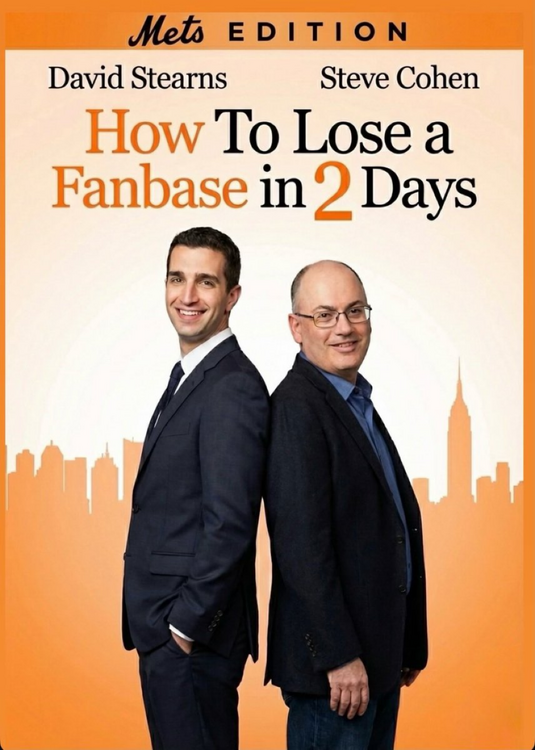-
Posts
14,423 -
Joined
-
Last visited
Content Type
Forums
Donations
News
Events
Gallery
Everything posted by samhexum
-

Hot New (Gay) Hockey Series on CRAVE
samhexum replied to dutchal's topic in TV and Streaming services
Heated Rivalry Renewed For Season 2 - TVLine WWW.TVLINE.COM Ice, ice baby! Heated Rivalry will be back for Season 2 — get details. -
I don't know if any of the other Progressive agents are going to guest star in the new season. I believe the son of the postal worker who had trained as a medic was played by the black agent. BTW, Jamie lost his safe driver discount a few years ago when he was involved in an accident on Station 19.
-

HAPPY 100th BIRTHDAY to Dick Van Dyke - a comedy legend
samhexum replied to + BOZO T CLOWN's topic in The Lounge
none of which I ever saw other than Shitty Shitty Bang Bang, which was what I came out of the theater singing as a young lad, and which is the only thing I remember about it other than there being some kind of flying car (I think) -
Just do what I did... Start episode two of BOOTS one evening, get 16 minutes and 44 seconds (including recap) into it, then start The Pitt instead and stay up all night and into the next morning and knock the whole thing off with only the occasional bathroom or snack break. It returns in January. It takes place ten months after the end of season one and takes place over the July 4th weekend. Dr. Collins (who had the miscarriage) won't be back. It wasn't her decision... as a fourth year resident at a teaching hospital, it was thought she would be going elsewhere so they let her go from the cast.
-
A grieving Colorado uncle allegedly body-slammed the defense attorney who was representing his nephew’s accused killer, knocking him unconscious and fracturing his spine. Daniel Ashby, 36, was charged with second-degree assault for using an “MMA-style takedown” on attorney H. Michael Steinberg inside the Arapahoe County Courthouse in Littleton, Colo., on Monday, CBS Colorado reported. Ashby was attending a court hearing for 19-year-old Christopher Ramirez-Rodriguez, who is accused of running a red light and killing Ashby’s 12-year-old nephew in July. Steinberg was representing Ramirez-Rodriguez when Ashby allegedly “aggressively approached” him in the hallway outside the courtroom while trying “to see the defendant,” according to an arrest record obtained by the outlet. Police said Steinberg pushed Ashby back to create space, after which Ashby allegedly carried out an “MMA-style takedown,” which left the longtime lawyer unconscious. Steinberg — who has frequently appeared as a guest on CNN and Fox News — was rushed to a local hospital, where he was treated for multiple spinal fractures. In an email sent Tuesday, Steinberg told CBS Colorado he also suffered a “shattered pelvis,” was in “serious pain,” and is scheduled to undergo surgery Thursday. Ashby was immediately taken into custody at the courthouse. Court officials said the hallway incident was not captured on video. Ashby is being held at the Arapahoe County Jail on a $75,000 bond and is due back in court Friday in connection with the alleged assault, according to jail records viewed by The Post. Ashby’s older brother, Michael Ashby — the father of the 12-year-old victim — said he attended Monday’s hearing but did not witness the incident. He said the entire family has been attending court proceedings and that emotions were running high. “The whole family is frustrated with this legal system,” Michael Ashby told CBS Colorado, adding that there has been significant tension between the two families. Court records show the judge overseeing the case later warned both families against “taking justice into their own hands.” According to public records cited by the outlet, Ashby has a lengthy criminal history that includes multiple violations of protective orders and jail sentences. Ramirez-Rodriguez is accused of killing Ashby’s 12-year-old nephew around 10 a.m. July 19 when he ran a red light as the boy was crossing the road on his electric scooter, the Aurora Police Department said. Police said he remained at the scene and was cooperative. Drugs or alcohol were not suspected, but distracted driving was being investigated as a contributing factor. Ramirez-Rodriguez was charged with careless driving resulting in death.
-
Texas agriculture officials issued an urgent alert this week after confirming that a newly identified invasive pest is spreading quickly across more than 20 counties, threatening grazing lands, hay production and livestock operations across the state. The insect, Helicococcus summervillei – known as the pasture mealybug – has never before been reported in North America. Texas Agriculture Commissioner Sid Miller said the pest is already causing visible damage in multiple regions. "This is a completely new pest to our continent, and Texas is once again on the front lines," Miller said. "If the pasture mealybug spreads across Texas grazing lands like it has in eastern Australia, it could cost Texas agriculture dearly in lost productivity and reduced livestock capacity." The Texas Department of Agriculture says it is working with Texas A&M AgriLife Extension Service and the USDA’s Animal and Plant Health Inspection Service to evaluate how far it is spreading and to determine the best emergency response strategy. The pasture mealybug was first described in Australia in 1928, according to AgriLife Extension publications, and was known to be responsible for millions of acres of lost pasture due to "pasture dieback." The publication describes the condition as when the insect feeds at the soil level and within plant tissues, weakening and eventually killing grass essential for grazing and hay production. While the species is believed to be new to North America, researchers suspect the insect has been present since before 2022. So far, state and extension experts have documented 20 counties as being infected. According to a Pest Incident Worksheet from AgriLife entomologists, the most significant pasture losses are in Victoria County. It’s also noted that the most susceptible grasses to infestation are Bermudagrass, Bahia grass, Johnsongrass, haygrazer (sorghum–sudangrass), St. Augustine grass, bluestem varieties and other tropical or subtropical grasses. Damage can be difficult to detect early because the insects feed low on the plant and beneath surface debris. Warning signs include yellowing within a week of infestation, purpling or reddening of leaves, stunting despite adequate moisture, weakening root systems and patchy areas of thinning or dead grass. The bugs appear as small white fuzzy clusters on grass or plant matter. As of now, there are no insecticides labeled for the control of the pest in the U.S. The wax-covered pasture mealybug, shown here on a damaged blade of grass, is causing dieback and threatening Texas grazing lands.
-

Hot New (Gay) Hockey Series on CRAVE
samhexum replied to dutchal's topic in TV and Streaming services
"The shower scenes are really funny, because we're wearing these really revealing intimacy garments," Connor Storrie told eTalk. "Nothing can get out of them, but when there's water involved, they fill up like this sort of water balloon. We're trying to be sexy and lather ourselves up while this water balloon is just growing on your body. And in between takes, you have to wring it out." Added Hudson Williams, "The B-roll can never be seen." In a separate interview with Entertainment Weekly, Storrie admitted that it's a "really interesting experience" watching Shane and Ilya's love scenes on screen. "When I watch it, I'm like, this is really not that raunchy because it's me," he said. "I remember doing that, but it's hard to remind yourself that anyone else who's seeing this was not there and did not watch this happen." Read More: Heated Rivalry: Everything To Know About The Gay Hockey Romance That's Steaming Up Social Media - TVLine WWW.TVLINE.COM Hockey fever is sweeping the globe, and it has nothing to do with the sport itself. Here's everything to know about the steamy Canadian... -
I feel your pain. I watched the first 1 1/3 episodes of BOOTS.
-
He’s been the NBA champ, a Finals MVP, and an All-Star nine times over, but the next box basketball star Giannis Antetokounmpo appears to be checking is the one for Brooklyn landlord. The Milwaukee Bucks’ big man has reportedly purchased a two-building apartment complex at 111 Clarkson Avenue in Prospect Lefferts Gardens for $14.1 million from Seth Brown and Richard Ludwig, the property’s developers. The 28-unit rent-regulated property sits just a block and a half east of Prospect Park, and current tenants have access to a handful of shared amenities, including a roof deck, a virtual doorman, a gym, and a pair of lounges. At the time of publishing, no apartments in the building were listed for rent, but a two-bedroom with one bathroom and a balcony went for $3,699 per month in October, according to Streeteasy. It should be noted Giannis happens to be one of the NBA’s most opportunistic investors, launching the sports-focused venture capital firm Build Your Legacy last year. He’s also a stakeholder in multiple professional sports teams, like the MLB’s Milwaukee Brewers and the MLS’ Nashville SC, and owns properties, commercial and residential, all over the world.
-
-
Rather an interesting fall finale.
-
Actor who appeared in ‘Marvelous Mrs. Maisel’ struck and killed by SUV driver in Midtown Manhattan: cops – amNewYork WWW.AMNY.COM A 60-year-old woman and actor who appeared in Amazon's "The Marvelous Mrs. Maisel" and other shows died this week after being struck by an...
-
Former NBA player Jason Collins announces he has Stage 4 brain cancer WWW.NYTIMES.COM Collins started experiencing symptoms while trying to pack for a US Open trip. He announced he has stage 4 brain cancer.
-
We've seen the last of Billy. His last episode was last week's . We'll learn his fate later in the season.
-
-
But once I decided to give up on it I decided to try The Pitt instead and I watched the whole season overnight.
-
I couldn't even get halfway through the second episode. I just didn't give a @&$! about Cam and had no interest in his story or any of the other characters'.
-
LOW COST APARTMENT AVAILABLE!!! Mamdani to move into Gracie Mansion, giving up his rent-stabilized apartment in Queens WWW.AMNY.COM Mayor-elect Zohran Mamdani will move into Gracie Mansion and said he will miss cooking dinner, riding the elevator and hearing music in... Mamdani to move into Gracie Mansion, giving up his rent-stabilized apartment in Queens.
-
32 of Our Most Warming Winter Soups APPLE.NEWS These hearty soup recipes span chicken noodle, clam chowder, seafood bisque, vegetable-bean, and more.
-
https://www.aol.com/articles/12-kfc-items-customers-suggest-164000308.html 12 KFC Items Customers Suggest You Avoid, According To Reviews Reddit, Yelp, and Google, as well as countless social media pages, are filled with some harsh truths about fast-food restaurants across the country, including KFC. In fact, KFC is a repeat offender and is rated one of the worst fast-food chains worldwide. One of the top consumer review sites has more than 6,000 bad reviews, with the majority being only one out of five stars.
-
Paramount Makes $77.9 Billion Hostile Bid for Warner After Netflix Struck Deal APPLE.NEWS Offer comes days after entertainment company reached $72 billion deal with streaming giant Netflix
-
Also meant to add that I hate the story-telling device of having a character talk to himself with the actor playing both sides of the conversation.
-
I know it's based on a true story but the first episode played like a badly-written Lifetime movie. If your lead character is dumb enough to think joining the marines will be like going to summer camp, he's too dumb for me to like or root for. And (again, I know it's based on a true story, but) his mother and brother (in his brief screen time) needed to have the word CLICHE flashing across the screen every time they appeared.
-
Watched the first episode. Didn't grab me. Will probably watch one more and unless it improves I'm out. I had no interest at all in the lead character. The others were interesting enough for me to try another but it's a tough sell when the lead character is not compelling.
-
Contact Info:
The Company of Men
C/O RadioRob Enterprises
3296 N Federal Hwy #11104
Ft. Lauderdale, FL 33306
Email: [email protected]
Help Support Our Site
Our site operates with the support of our members. Make a one-time donation using the buttons below.





















